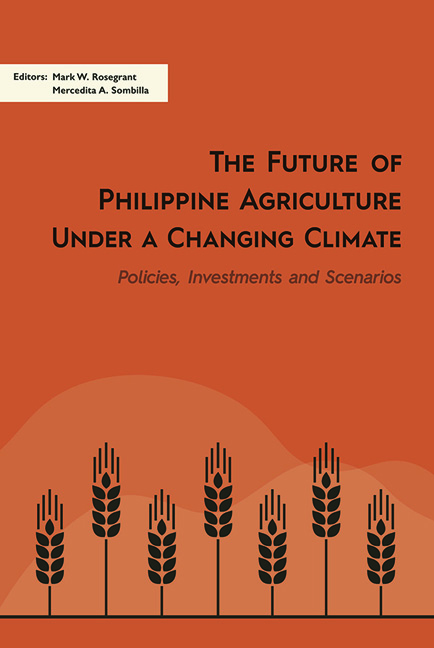Book contents
- Frontmatter
- Contents
- List of Tables
- List of Figures
- List of Appendices
- Preface
- Acknowledgements
- List of Contributors
- PART I Setting up the Scenarios: Current Status and Potential Impacts of Climate Change to Philippine Agriculture
- PART II Climate Change Adaptation Strategies and Sustainability of Philippine Agriculture
- 5 The Sustainability of Agricultural Growth
- 6 The Gendered Impacts of Climate Change
- 7 Adaptation and Mitigation Strategies
- 8 Risk Management and Coping Strategies
- PART III Investments and Supporting Policies to Alleviate Climate Change Impacts to Philippine Agriculture
- PART IV Conclusion
- Index
6 - The Gendered Impacts of Climate Change
from PART II - Climate Change Adaptation Strategies and Sustainability of Philippine Agriculture
Published online by Cambridge University Press: 29 May 2019
- Frontmatter
- Contents
- List of Tables
- List of Figures
- List of Appendices
- Preface
- Acknowledgements
- List of Contributors
- PART I Setting up the Scenarios: Current Status and Potential Impacts of Climate Change to Philippine Agriculture
- PART II Climate Change Adaptation Strategies and Sustainability of Philippine Agriculture
- 5 The Sustainability of Agricultural Growth
- 6 The Gendered Impacts of Climate Change
- 7 Adaptation and Mitigation Strategies
- 8 Risk Management and Coping Strategies
- PART III Investments and Supporting Policies to Alleviate Climate Change Impacts to Philippine Agriculture
- PART IV Conclusion
- Index
Summary
Agriculture and food systems are among the top-ranked sectors deemed most vulnerable to the adverse impacts of climate change (IPCC 2012, p. 235). This is especially so for developing economies, such as the Philippines, where small-scale and subsistence farming predominates, and eradicating poverty is a fundamental development priority. Confronted with all of its challenges within the context of climate change, the sustainability of the agricultural sector is pressed not only in terms of its capacity to meet current and future food security objectives, but also in terms of its ability to provide an appropriate standard of living, including equity, access to productive resources, social protection, and participation in democratic processes. Any analysis of the vulnerability of the agricultural sector would be incomplete without a consideration of the inherent gender dimension.
This chapter presents the results of research designed to examine gender dynamics within the Philippine agricultural sector in the context of climate change. Despite the limited existing body of literature on the subject, the findings offer insight into the gender-differentiated impacts of climate change, gendered responses to such impacts within the agricultural sector, and opportunities for gendered voices and perspectives within the Philippine's climate change policy framework. The intent is to promote and guide gender-sensitive decisions that are imperative to equitable and sustainable food and nutrition security, income generation, and improved rural livelihoods.
THE MULTIDIMENSIONAL NATURE OF GENDER EQUALITY
In addressing the adverse impacts of climate change on the agricultural sector, success in mainstreaming the gender dimension requires acknowledgement of the multidimensional nature of gender equality. Awareness of the reality that climate change does not affect people equally continues to grow (IPCC 2007, pp. 17, 359; IPCC 2012, p. 7; Mearns and Norton 2010, p. 5; Nellemann, Verma, and Hislop 2011, p. 8; Goh 2012, pp. 1–2). In a special report for policymakers, IPCC (2012, p. 7) noted that people — either as individuals or collectives — are differentially vulnerable to the impacts of climate change on the basis of disparities in economic and social well-being, including factors of health, gender, and class. A number of focused group discussions conducted similarly indicate that even in an agriculture-based community, finer sectoral categorizations can be identified as vulnerable to impacts of climate change (Table 6.1).
- Type
- Chapter
- Information
- The Future of Philippine Agriculture under a Changing ClimatePolicies, Investments and Scenarios, pp. 260 - 277Publisher: ISEAS–Yusof Ishak InstitutePrint publication year: 2018

